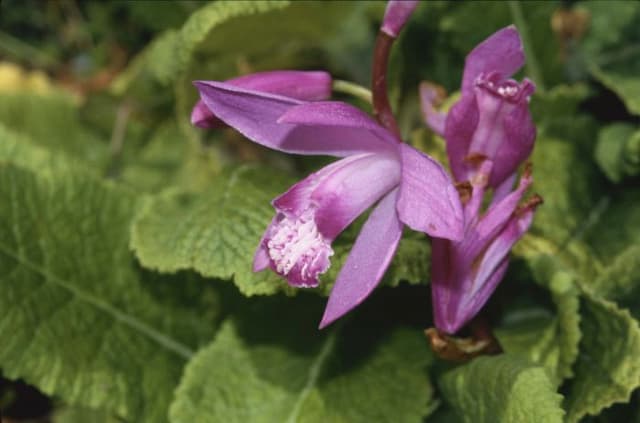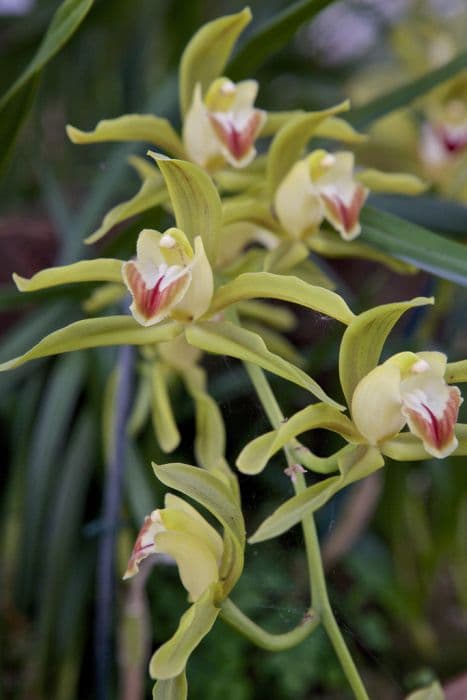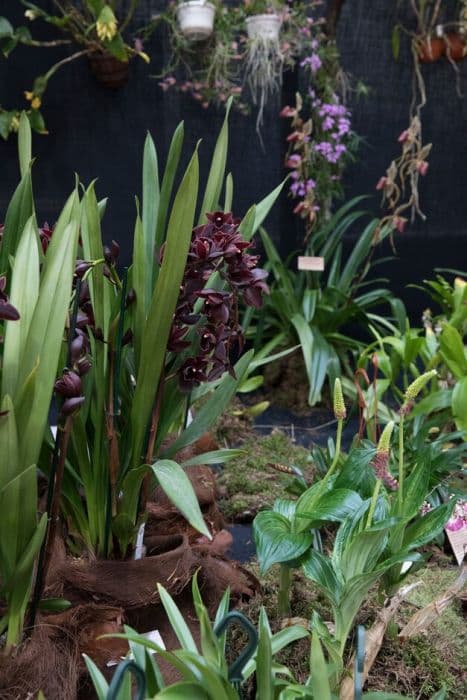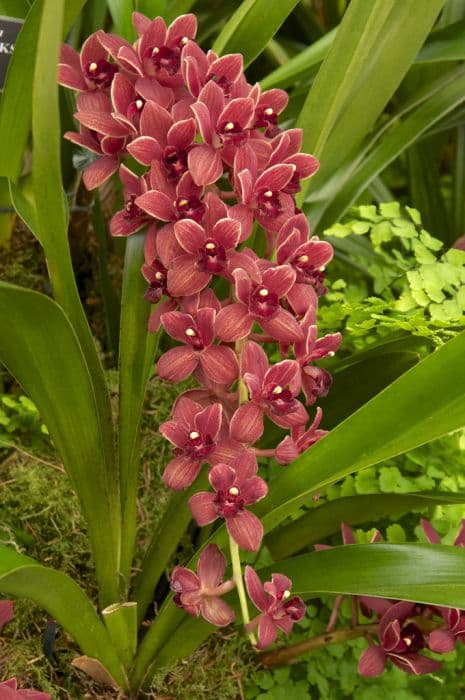Spider Orchid Brassia Orange Delight gx

ABOUT
The Brassia Orange Delight gx, commonly known as the Spider Orchid, is a captivating plant known for its distinctive floral display. This orchid variety has long, slender petals and sepals which splay outward resembling the legs of a spider, giving it an exotic and wild appearance. The color of the flowers is a striking blend of orange and yellow hues with some having spots or markings in a deeper red-brown. The petals are typically elongated, while the lip, also referred to as the labellum, contrasts in shape, being broader and sometimes featuring a different pattern or coloration that aids in attracting pollinators. The Spider Orchid emits a delicate fragrance that can vary in intensity and is more noticeable at certain times of the day. The plant has elongated, leathery leaves which grow in a monopodial pattern. These leaves are usually bright green, which provides a lovely backdrop that further accentuates the beauty of the blossoms. Overall, the Spider Orchid is a visually intriguing plant that is prized for its unique and dramatic flowers.
About this plant
 Names
NamesFamily
Orchidaceae
Synonyms
Spider Orchid, Brassia Orange Delight
Common names
Brassia Orange Delight gx.
 Toxicity
ToxicityTo humans
The Brassia Orange Delight, commonly referred to as a Spider Orchid, does not have notable toxicity to humans. These ornamental plants are generally considered safe and there is no widespread evidence of poisoning upon ingesting parts of this plant. Nonetheless, it is advisable to avoid consuming non-food plants as a general safety precaution.
To pets
Similar to humans, the Spider Orchid is also not known to be toxic to pets. It is not associated with poisoning when pets, such as cats or dogs, come into contact with or ingest parts of the plant. However, it is always a good idea to monitor pets around plants and discourage them from chewing on any houseplants to prevent any potential gastrointestinal upset purely from the act of ingesting non-digestible matter.
 Characteristics
CharacteristicsLife cycle
Perennials
Foliage type
Evergreen
Color of leaves
Green
Flower color
Orange
Height
1-2 feet (30-60 cm)
Spread
1-2 feet (30-60 cm)
Plant type
Orchid
Hardiness zones
10
Native area
South America
Benefits
 General Benefits
General Benefits- Ease of Care: Brassia orchids are known for being relatively easy to maintain, making them suitable for orchid beginners.
- Aesthetic Appeal: With striking spider-like blooms, Brassia orchids add exotic beauty to any indoor space.
- Long Blooming Period: These orchids often provide an extended blooming period compared to other household plants.
- Fragrance: Some varieties of Brassia, including Brassia Orange Delight gx, may have a pleasant fragrance that can add a subtle, natural scent to your home.
- Variety of Uses: Brassia orchids are versatile and can be used as tabletop plants, hanging plants, or in orchid arrangements for various decorative purposes.
- Positive Psychological Effects: The presence of flowering plants like the Brassia orchid can have a calming effect and improve overall well-being and mood.
 Medical Properties
Medical PropertiesThis plant is not used for medical purposes.
 Air-purifying Qualities
Air-purifying QualitiesThis plant is not specifically known for air purifying qualities.
 Other Uses
Other Uses- Floral Arrangements: The unique spider-like blooms of Brassia can add exoticness and a tropical flair to both fresh and dried floral arrangements.
- Educational Tool: Brassia Orchid can be used in horticultural classes to teach about orchid care and the diversity of orchid species.
- Photography Subjects: The striking appearance of Brassia Orchids makes them excellent subjects for photographers specializing in plant or macro photography.
- Perfumery: Although not commonly used, the Brassia Orchid's fragrance can inspire new scent combinations in the art of perfumery.
- Artistic Inspiration: The unique structure and colors of the Brassia Orchid can provide inspiration for artists in various mediums, such as painting or sculpture.
- Fashion Design: The Brassia's distinctive shapes and patterns can inspire prints and motifs in the fashion industry.
- Interior Design: Live plants or high-quality silk replicas can be used as part of interior décor for a natural and elegant aesthetic appeal.
- Therapeutic Art: Engaging in the delicate art of orchid care can provide a form of relaxation and therapeutic benefit for enthusiasts.
- Biology Research: Can be used in research to understand plant pollination strategies and co-evolution with pollinators.
- Ecosystem Education: Brassia Orchid can help demonstrate the interconnectedness of tropical ecosystems and the importance of plant biodiversity.
Interesting Facts
 Feng Shui
Feng ShuiThe Spider Orchid is not used in Feng Shui practice.
 Zodiac Sign Compitability
Zodiac Sign CompitabilityThe Spider Orchid is not used in astrology practice.
 Plant Symbolism
Plant Symbolism- Uniqueness: The Brassia, commonly known as the Spider Orchid, often symbolizes uniqueness due to its distinctive shape and form that set it apart from other orchid varieties.
- Rarity: Symbolizing rarity, Spider Orchids are not as commonly found as some other orchid species, making them a special and sought-after plant.
- Beauty: With its striking appearance, the Spider Orchid represents beauty, reminding us of the diverse and intriguing variations that exist within the plant world.
- Mystery: The unusual look of the Spider Orchid often leads to it being representative of mystery, reflecting the enigmatic allure of exotic and lesser-known plant species.
- Complexity: The intricate structures of the Spider Orchid’s blossoms can signify complexity, mirroring the multifaceted elements of nature and life.
 Water
WaterThe Spider Orchid should be watered approximately once a week, but frequency may vary depending on environmental conditions. Ensure the potting mix is nearly dry before rewatering. Employ the soak and dry method, where you water the plant thoroughly, allowing excess water to drain away. Typically, during each watering, use about 8-16 ounces of water, but adjust this amount based on the pot size and the plant's needs.
 Light
LightSpider Orchids thrive best with bright, indirect light. Avoid direct sunlight that may scorch the leaves. A north or east-facing window is often a good spot, providing the diffuse light they prefer.
 Temperature
TemperatureSpider Orchids prefer temperatures between 60 to 80 degrees Fahrenheit. They can tolerate a drop to about 55 degrees at night and should not be subjected to temperatures below 50 degrees or above 85 degrees to prevent stress and damage to the plant.
 Pruning
PruningPruning Spider Orchids is primarily done to remove dead or damaged growth and to maintain plant shape. Prune after the orchid has finished blooming, using sterilized cutting tools to prevent the spread of disease. Pruning once a year is generally sufficient.
 Cleaning
CleaningAs needed
 Soil
SoilThe Spider Orchid 'Orange Delight' requires a well-draining orchid potting mix, typically composed of bark, perlite, and charcoal. This epiphytic plant thrives with a slightly acidic to neutral pH level between 5.5 and 7.
 Repotting
RepottingSpider Orchids like 'Orange Delight' should be repotted every 2 to 3 years or when the potting medium starts to decompose.
 Humidity & Misting
Humidity & MistingSpider Orchids, including 'Orange Delight', prefer high humidity levels, ideally between 40% and 70%.
 Suitable locations
Suitable locationsIndoor
Place in bright, indirect light and high humidity.
Outdoor
Shelter in dappled shade, protect from extremes.
Hardiness zone
9-11 USDA
 Life cycle
Life cycleThe Brassia Orange Delight gx, commonly known as the Spider Orchid, begins its life cycle as a seed, typically dispersed by wind due to its minuscule size and lightweight nature. Once the seed lands on a suitable substrate, often in the crevices of tree bark, it germinates and develops into a protocorm, which is an early growth stage that eventually gives rise to the first leaves and roots. The protocorm grows into a young orchid plant, producing pseudobulbs and foliage, and can take several years to mature before it's capable of flowering. The flowering stage occurs when the plant is mature enough, characterized by the production of distinctive, long, and spider-like blooms, ranging in hues from yellow to orange, often with a pattern of spots or other markings. After pollination, which is sometimes facilitated by mimicry attracting pollinators such as wasps, the flowers produce seed capsules containing numerous tiny seeds, and the cycle begins anew. The plant continues to grow and produce new pseudobulbs, allowing for the annual cycle of blooming, typically in the spring or summer, depending on the climate and growing conditions.
 Propogation
PropogationPropogation time
Spring-Early Summer
Brassia Orange Delight, commonly referred to as Spider Orchid, is typically propagated through division, a process best carried out in the spring or just after the plant has finished flowering. To propagate by division, carefully remove the orchid from its pot and gently separate the pseudobulbs, ensuring that each division has at least one growth point. Re-pot the divisions in fresh orchid potting mix, and water them sparingly until new growth appears, indicating the plant has established. This method allows for the rapid increase of orchid stock while maintaining the characteristics of the parent plant.








